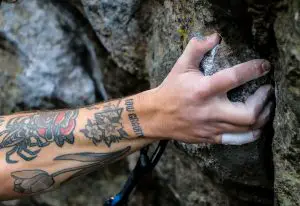Rock Climbing Terminology: A Complete Guide for Beginners

Are you new to rock climbing and feeling overwhelmed by all the jargon and terminology? Don’t worry, we’ve got you covered! Understanding rock climbing terminology is essential for effectively communicating with fellow climbers and ensuring your safety on the rock.
In this article, we’ll provide you with a comprehensive overview of the most commonly used rock climbing terms and explain what they mean. Whether you’re a beginner wanting to learn the basics or an experienced climber looking to brush up on your knowledge, keep reading to up your climbing vocab game.
Quick Links
What is Rock Climbing?
So what exactly is rock climbing? Is it scrambling? Not quite. Rock climbing is a challenging and exhilarating sport that involves ascending rock formations, both natural and artificial, using various techniques and equipment.
It is a physically demanding activity that requires strength, endurance, and mental focus. Rock climbing can be enjoyed both indoors on specially designed climbing walls or outdoors on cliffs, mountains, or boulders.
And with that, all the terminology that comes with it. So let’s get this started.
Types of Rock Climbing
- Top Rope Climbing: In top rope climbing, a rope is anchored at the top of the climbing route and the climber is securely attached to the rope while ascending. This type of climbing is typically recommended for beginners as it offers a higher level of safety.
- Lead Climbing: Lead climbing involves the climber attaching their own rope to anchors as they ascend. This requires more advanced skills and knowledge of equipment and techniques.
- Bouldering: Bouldering is a form of rock climbing that is done on shorter rock formations or artificial climbing walls without the use of ropes or harnesses. Climbers rely on crash pads and spotters for safety.
- Trad Climbing: Traditional climbing, or trad climbing, involves placing and removing gear such as cams and nuts into cracks in the rock to create temporary anchors for protection.
- Sport Climbing: Sport climbing is a form of rock climbing where permanent anchors are already in place, allowing climbers to clip their ropes into these anchors for protection as they ascend.
- Free Soloing: Considered the most dangerous form of rock climbing, free soloing is climbing without the use of ropes, harnesses, or protective equipment. It requires exceptional skill, experience, and risk assessment.
Each type of rock climbing offers a unique experience and requires different skills and equipment. It is important for beginners to start with top rope climbing and gradually progress to more advanced types as their skills and knowledge develop.
Essential Gear for Rock Climbing
- Climbing Harness: A harness is essential for attaching yourself to the rope and providing support during climbs.
- Climbing Shoes: Purpose-built climbing shoes with sticky rubber soles are crucial for precise foot placements and grip.
- Chalk Bag: A chalk bag is used to keep your hands dry and improve grip on holds.
- Belay Device: A belay device is used to control the rope during belaying, a technique where one climber manages the rope for another.
- Carabiners: These metal clips are used to connect various pieces of climbing gear and provide a secure attachment point.
- Climbing Rope: A dynamic climbing rope is used to protect against falls and is an essential safety device.
- Quickdraws: Quickdraws are used to attach the rope to bolts or protection points on the rock, allowing for easy clipping and protection during climbs.
- Helmet: A climbing helmet protects the head from falling rocks or accidental impacts. Simple enough, right?
- Nut Tools and Cams: These devices are used to place removable protection in cracks or crevices on the rock.
- Slings and Webbing: Slings and webbing are used for building anchors, extending protection, and creating adjustable friction hitches.
- Climbing Backpack: A backpack specifically designed for climbing holds your gear and essentials while allowing freedom of movement.
When it comes to rock climbing gear – most of this stuff is a must. Having the right gear is crucial for a safe and enjoyable climbing experience. Always ensure your gear is in good condition, properly fitted, and suitable for the type of climbing you will be doing. Familiarize yourself with how to use and maintain each piece of gear to ensure its effectiveness and reliability.
Common Rock Climbing Techniques
- Smearing: This technique involves using the friction between the climbing shoe and the rock surface to maintain balance and support.
- Edging: Edging is the act of using the edges of the climbing shoe to gain traction on small footholds or narrow ledges.
- Flagging: Flagging is the process of using one leg to provide balance and counterbalance while reaching for holds or making dynamic moves.
- Heel Hooking: Heel hooking is a technique in which the climber uses the back of their heel to secure a hold and provide additional stability.
- Toehooking: Toehooking is similar to heel hooking, but instead of using the heel, the climber uses the front part of their shoe to hook onto a hold.
- Crimping: Crimping involves using the fingertips to hold onto small, shallow holds.
- Gaston: A gaston is a type of handhold grip where the palm is facing inwards with the thumb pointing out, providing leverage and stability.
- Slopers: Slopers are large, rounded holds that require a combination of friction and body tension to grip and maintain balance.
- Underclings: Underclings are holds that require the climber to pull upwards and use opposing pressure to stay on the wall.
- Liebacks: A lieback is a climbing technique where the climber uses their body to make a sideways pull on a corner or crack.
These are just a few of the common rock climbing techniques that climbers of all levels use to navigate different types of rock formations and challenges. As you progress in your climbing journey, you will continue to develop and refine your technique, improving your efficiency and ability to tackle more advanced climbs.
Other Common Rock Climbing Terms
- Belay: The act of controlling the rope for a climber, providing safety and support.
- Crag: A small or medium-sized rock face suitable for climbing.
- Crux: The most difficult or challenging part of a climb.
- Protection: Equipment placed in the rock to protect against falls, typically including cams, nuts, and bolts.
- Rappel: Descending a rope using a specialized device, also known as abseiling.
- Route: A specific path or sequence of moves to climb a particular section of rock.
Understanding these common rock climbing terms will help you communicate effectively with fellow climbers and navigate the climbing community with confidence.
As you gain experience and immerse yourself in the sport, you will encounter even more specialized terminology that will enhance your climbing knowledge and skills.
Conclusion
Rock climbing is a thrilling and rewarding sport that offers a unique connection with nature and an opportunity to push your limits. Whether you’re a beginner or an experienced climber, it’s important to prioritize safety, equip yourself with the necessary gear, practice proper climbing techniques – and of course, knowing the terminology.






